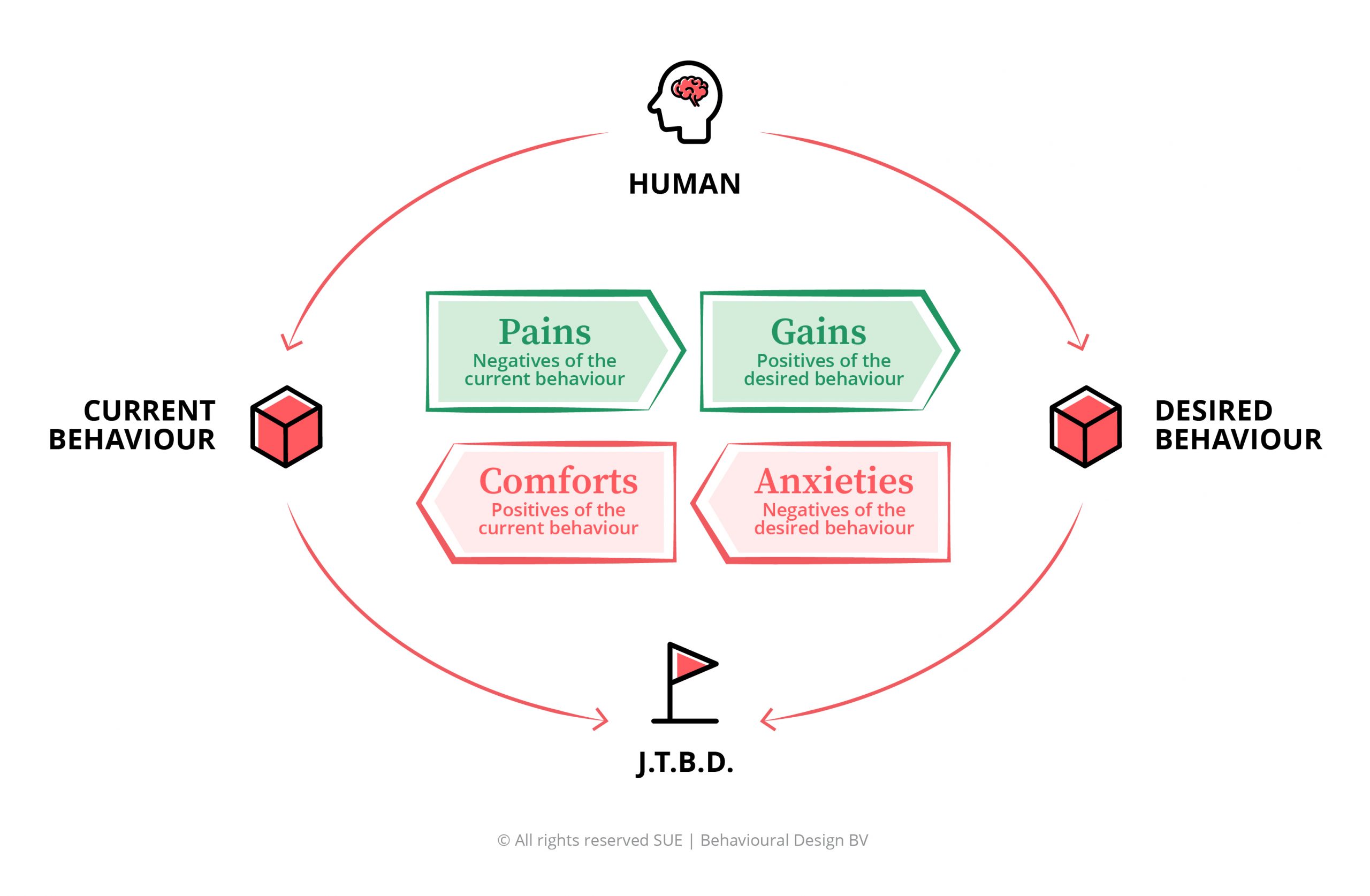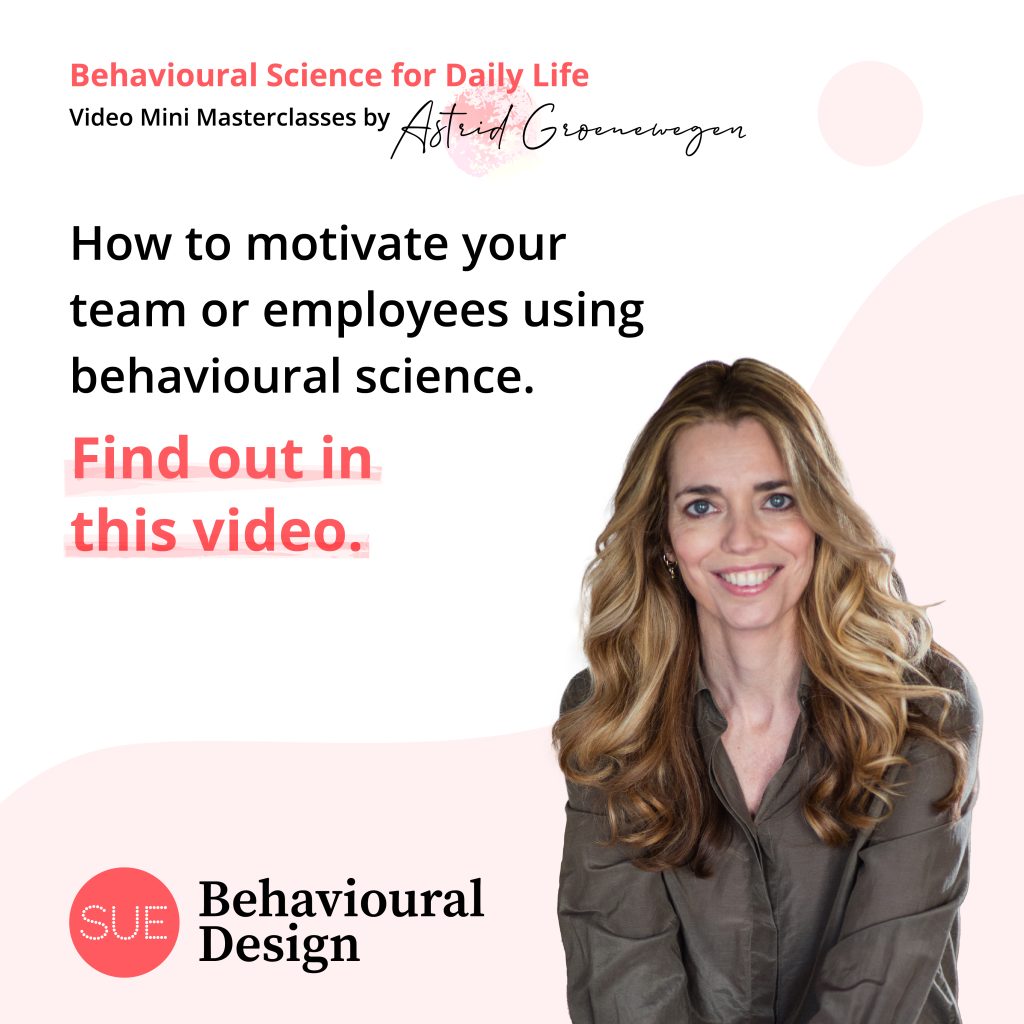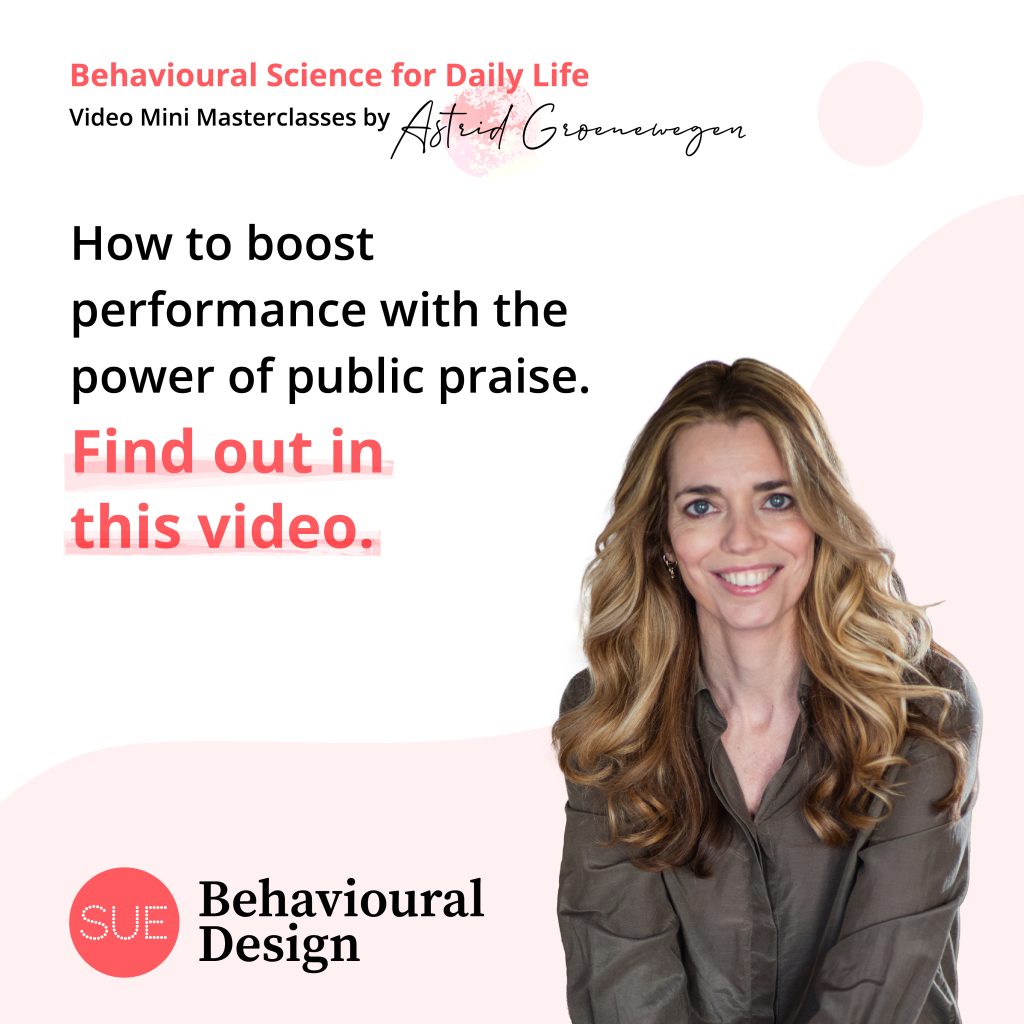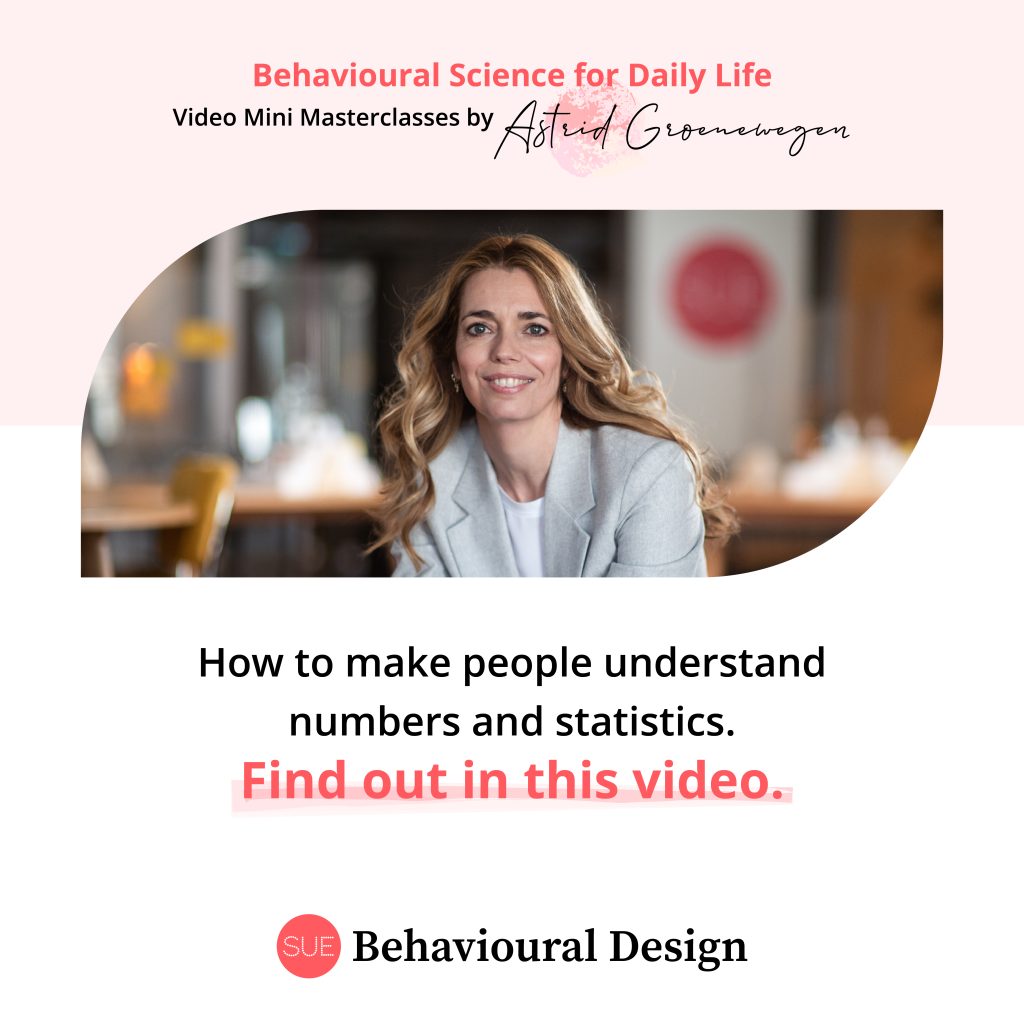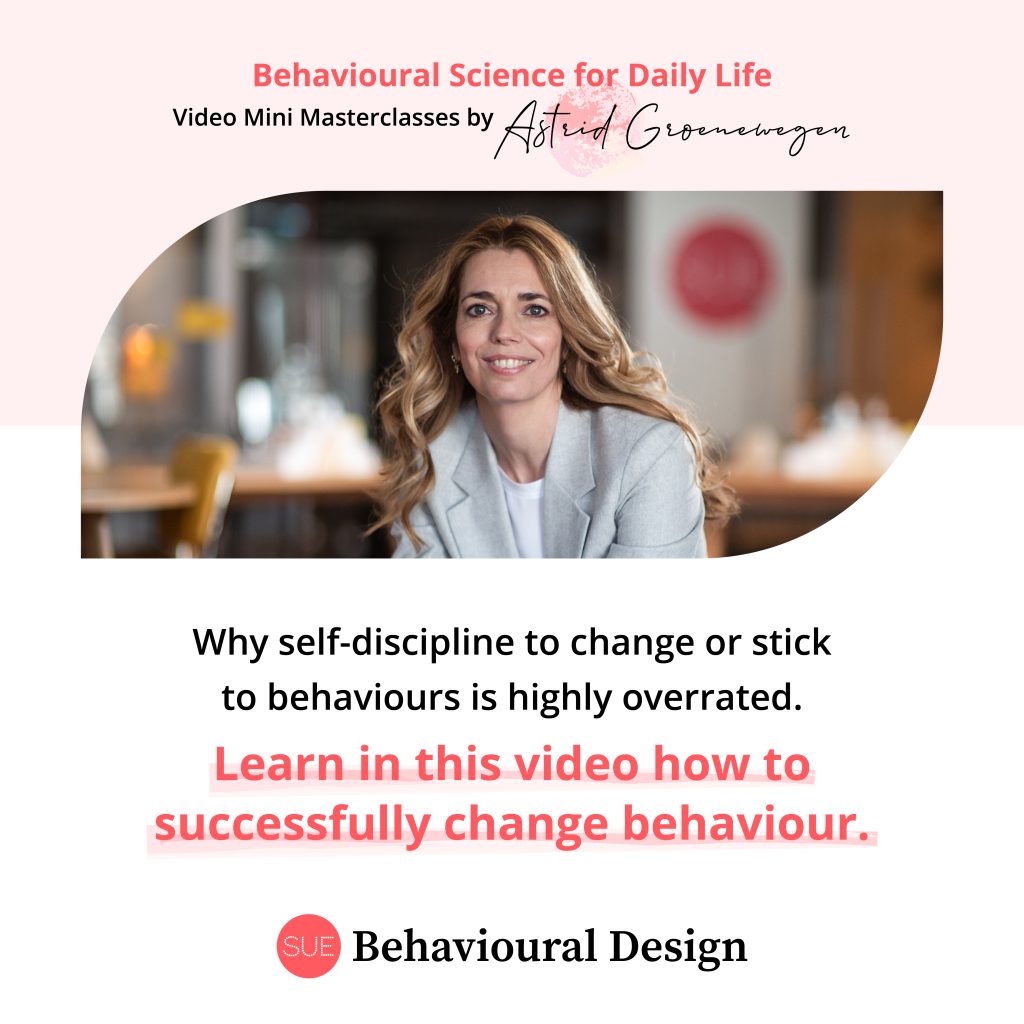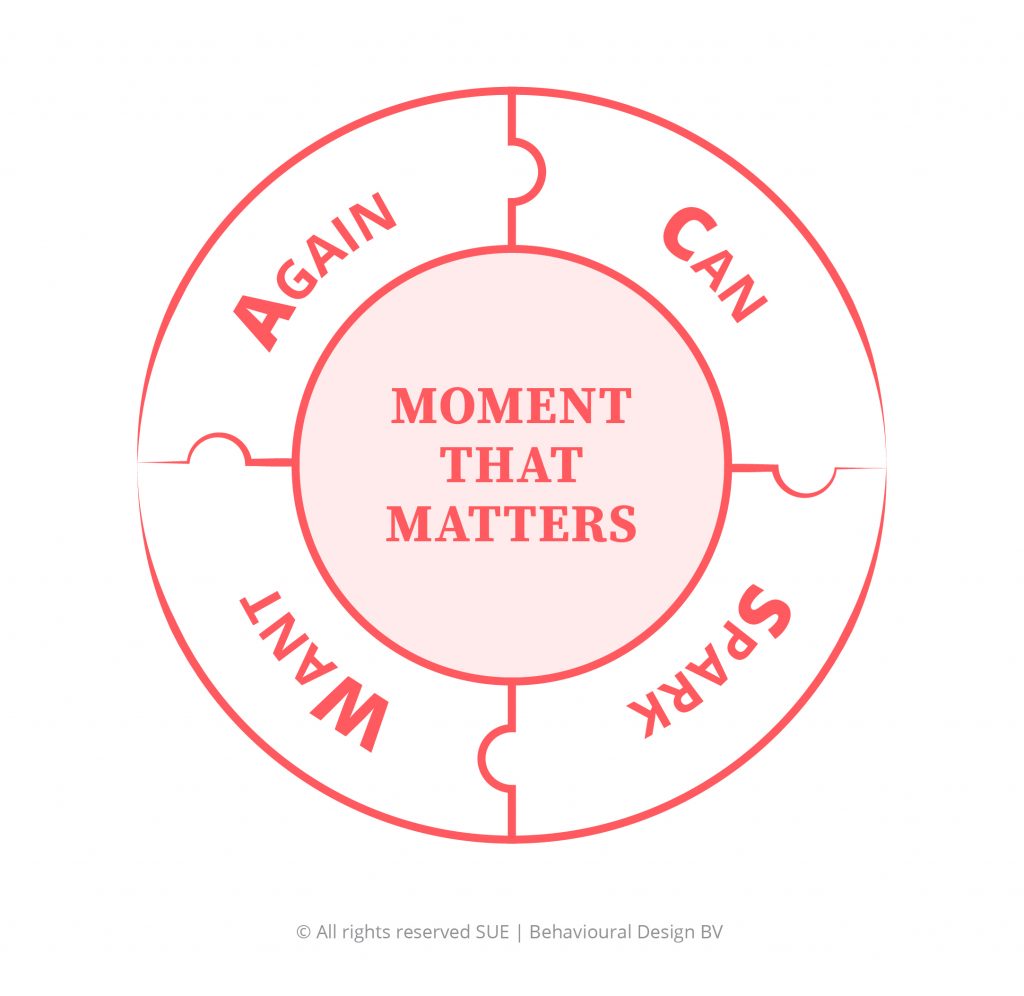
Changing behaviour is challenging but certainly not impossible. With the right tools in your Behavioural Design toolbox, you can leverage the power of behavioural science to shape positive behaviours and influence better decisions. This blog post introduces you to the SUE | SWAC Tool©. An easy-to-use tool to develop interventions that will change behaviour predictably. It is part of our SUE | Behavioural Design Method© and the second step after unlocking human insights with our SUE | Influence Framework©. The SWAC Tool© will turn insights into tangible ideas to develop better products, services, policies, campaigns or living environments.
How to design behaviour: Moments that Matter
Behavioural Design is all about creating a context to trigger people to make a decision or take action towards their goals. So, what is needed at this point is knowing what makes up for this context.
The key in creating an influential context is timing: designing for the moments that matter.
When you want to influence choice and shape behaviour you are designing for moments that matter. When is someone most susceptible to change? Or what are the moments we have to make sure someone gets triggered into action? These can be existing moments or moments that we have to create. You will have gained valuable insight into these moments from the Influence Framework©. But there is another way you have to look at moments that is related to the timeframe needed for behaviour to occur. This has to do with the type of behaviour you are designing for.
It is important to realise that not all behaviour is created equal. Sometimes you need someone to engage in entirely new behaviour (could be going on a sugar-free diet after being diagnosed for diabetics or doing banking online for the first time) and sometimes you need someone to pick up abandoned behaviour they were already familiar with, but somehow stopped doing (could be exercising or going to dentist appointments). Sometimes you need someone to do something once in a one-off behaviour (sign-up for organ donation, apply for university, register online on your website) but often we want someone to engage in the repeat behaviour (showing up at doctor’s appointments on time, not using their phone in traffic, buying multiple products or services from you, making donations). To make things somewhat simpler again, the best starting point is to separate two types of behaviours:
– One-off behaviour (such as registering for organ donation)
– Repeat behaviour (such as a healthy eating habit)
You can imagine if you want someone to only do something once you have less convincing to do and it most probably can be done in a shorter timeframe. On the other hand, routine behaviour takes some more effort and you need to be at someone’s side a bit longer. So, you need to know which one of the two behaviours you are dealing with in the first place.
What about the new and abandoned behaviour then? Well, the fact is, if you want someone to show different behaviour (the whole point of coming up with interventions is causing a behaviour shift) it means he or she has to stop what he or she is doing now. Therefore, you have to consider all desired behaviour as a new behaviour. Even if the behaviour is obvious to someone (such as going to school) or someone knows he/she has to do it (such as paying taxes). But what about the abandoned behaviour then? This is actually a very important notion to consider.
A key in successful Behavioural Design is the acceptance that people will have moments of weakness or forgetfulness and slip into old behaviours again.
So, to get back to routine behaviours just a bit. I know a lot has been written and said about building habits and routines. Some tell you to stick to behaviour for 21 days, others claim that 30 or 90 days are needed to create routine behaviour. I am not sure what is the magic number. The only thing I am sure of (or have experienced myself) is that:
There is a dark side to goals, plans and habits: they are very fragile and therefore you need to be prepared for failure.
Failure seems to hit us time and again. That’s why I love Buster Benson’s ‘Chaos Monkey’ approach to life: don’t ignore the fact that we are vulnerable to having our goals, plans and habits being disrupted by ‘the first rainy day, sick day, vacation day, holiday, grumpy day, low-energy day, or otherwise non-standard day’. The Chaos Monkey comes and disrupts us time and again. If you are designing choice and behaviour, you also have to do this with the Chaos Monkey in mind. People will trip despite their good intentions and slip back into old behaviours. You need to be there at the tripping points, aka (yes you know what’s coming) moments that matter.
Change doesn’t happen overnight for any behaviour.
That’s why you should integrate multiple moments that matter into your intervention strategy. We always like to think about ‘onboarding’ someone. Making sure you stick by someone multiple times, especially in the beginning, and design for those moments that someone will find it hard to show the desired behaviour.
Let me wrap this up by giving you an example about designing an intervention strategy for one of our clients, a national fitness chain. From the membership data, we learned that people continued coming to the gym once they exercised a minimum of two times a week for three months. This is the point that they would actually come to the gym on a regular basis (members have to check in with their membership card at every visit, this is how the data is collected) and renew their memberships. Therefore, we knew we were designing for routine behaviour. We also knew them that the three-month timespan was needed to turn exercising into a habit instead of a strenuous to-do. We looked within that timespan for the moments that matter. Some came from our research. For instance, we found out that making sure you pack your sporting bag the evening before highly correlates with actually going to the gym the next day. But other moments we had to create. The real job of the gym was to keep onboarding people who failed to build up a routine.
You have to design a series of specific, new behaviours for any new behaviour to become a routine.
That’s why we came up with interventions that not only helped someone pack their sporting bag, but we looked into the entire three-month timespan and made sure we designed interventions to help someone make it through successfully. We helped someone book a personal trainer intake, we phoned them after a few weeks, we helped them join classes, we helped them exercise at home, just to name a few. The interesting insight for our client was that they were not in the business of gyms, but they are in the business of building an exercise routine. This opened up a world of different interventions (and new business ideas as a matter of fact).
Want to learn how to shape behaviour and decisions?
Then our two-day Fundamentals Course is the perfect training for you. You will learn the latest insights from behavioural science and we'll teach you how to use tools such as the SWAC Tool© to apply the best of behavioural science in practice right away!
How to design behaviour: SWAC
A lot of very interesting research has been done in the behavioural change field of expertise. And it can get quite complicated. That’s why we simplified it again. Without further ado let’s take a look at the SUE | SWAC Tool©. It is foremost a very easy-to-use tool. It explains which four pieces of the puzzle you need to solve to create a context that will persuade someone into doing something and to have them keep doing it. What makes the tool so easy to use in practice, is that anytime you want to design for behavioural change, all you have to do is ask yourself four simple questions:
When the new behaviour does not happen, at least one of those four elements is missing. The most important implication of this is that by using the SUE | SWAC Tool© as a guide you can quickly identify what stops people from performing the behaviours that you seek.
If a sufficient degree of capability (CAN) to perform a behaviour is matched with the willingness (WANT) to engage in that behaviour, all that is then needed for the behaviour to occur is to set someone into action (SPARK) at the Moments that Matter.
Maybe you notice that in the tool it says moments that matter. Not one moment, but moments. As we learned, behavioural change doesn’t happen overnight. Most of the time someone needs to be reminded of the desired behaviour more than once for it to happen in the first place. Furthermore, behaviour becomes easier when repeated. Therefore, we have to make sure we SPARK someone AGAIN and again to activate the desired behaviour. So, you need to design several interventions at multiple moments that matter. In practice your intervention strategy will look something like this:
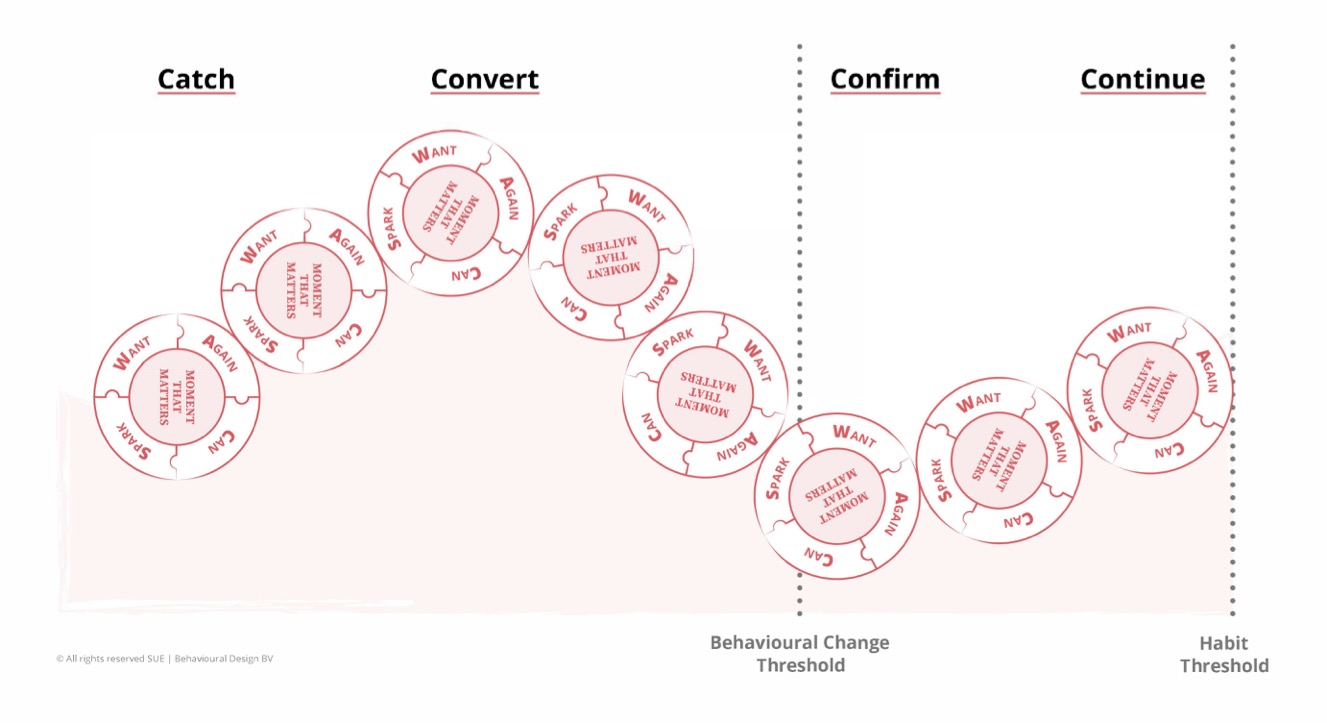
The objective of most intervention strategies is not only to change behaviour but to change this new behaviour into a routine behaviour (a habit), so the new behaviour will stick.
Remember, your desired behaviour is new behaviour for people and that’s why it is important to spark behaviour AGAIN and again. Only then the behaviour will take place, as illustrated above as the BEHAVIOURAL CHANGE THRESHOLD. When your objective is to design repeat behaviour, it almost goes without saying that you have to make sure the desired behaviour is performed repeatedly. If you can make someone perform new behaviour over and over AGAIN, it can become automatic.
The result being that someone doesn’t have to think about the new behaviour anymore, he or she simply does it. This way it can become habitual. Illustrated above model as the HABIT THRESHOLD. As Aristotle already stated:
We are what we repeatedly do.
He added ‘Excellence, then, is not an act, but a habit’. To sum it up: The more often you do something, the easier it gets. So, there you have it: the four elements you need to change behaviour.
Aristotle quote, ancient Greek philosopher, scientist and physician, 384 BC-322 BC, no original source known.
How to design behaviour: Capability
Before we start working with the tool, let’s go back one little bit. As Behavioural Designers our outset is to design for someone’s system 1.
Our job is to help people make better decisions without them having to think.
This is the foundation of this model. When you look at willingness (WANT) and capability (CAN) there is something very interesting and important going on. We are all so used (and trained) to have the best arguments, deals, offers, rewards or promises to convince someone (or ourselves). Historically, we are all shaped around motivation (WANT). If we need to sell something, we are hardwired to try to create willingness to buy. If a personal resolution fails, our first (conditioned) conclusion is that we must not have wanted it badly enough to keep up the self-discipline.
What if I tell you that making sure someone wants something often isn’t the most powerful starting point to change behaviour? Making someone WANTs to perform the desired behaviour is just one side of the medal in getting things done. In fact, it even isn’t the shiniest side of the medal. Here’s why. There is something particular going on with people’s willingness to change; It goes up and down. When relating this to our fundamental know-how on human decision-making this makes perfect sense, as:
Willingness to change requires cognitive action.
It is a system 2 activity like self-control and focus. You cognitively decide you want something. You decide this consciously. I want to lose weight, I want to save money, I want to recycle, I want to spend more time with my kids. We have learned that our system 2 has only limited bandwidth. Therefore, your willingness to change falters, it goes up and down in waves. This is the reason why most new year’s resolutions fail. On January 1st you WANT to lose weight, or you WANT to stop drinking or you WANT to go to the gym. And then comes along your best friend’s birthday. Or you’ve pulled a whole-nighter because that precious offspring of yours refused to sleep. And now you don’t WANT to exercise and not drink anymore. You want to vegetate on the couch (sleep deprivation isn’t a walk in the park) or have a blast (hey your friend only turns 40 once). You feel so deserving (your system 2 post-rationalisation working full speed for you) and so you will start next month. You simply CANnot do it today. Your willingness to change behaviour has dropped like a mic on an empty stage. This is perfectly human, but something we have to take into account when designing for behaviour change. Chaos Monkey Galore!
Luckily, as Behavioural Designer, you have an ace up your sleeve by making behaviour very simple. Our brain LOVES simple. Bonus is that when things are simple, we are able to do things without needing that much willingness. That’s why we always start with thinking about possible CAN interventions. This is designing for system 1. The best behavioural change ideas are in their core capability ideas.
Making something very easy to do is something that requires little or no cognitive action from someone.
Let me illustrate how this can work with a real-life example. Most people WANT to save money, but many of find it hard to do (CAN). You could design saving behaviour without having to really stress the willingness to save too much but by focusing on making saving behaviour easier instead. This is exactly what Bank of America did. Their human insight was that people wanted to save money, but never did especially making regular contributions was very hard. They have introduced a program called ‘Keep the Change’. What it boils down to is that every time a client pays with his or her debit card for daily purchases like buying coffee, going to the dry cleaners and so on, they round up their purchase to the nearest dollar amount and transfer the change from someone’s checking account to their savings account — or to their child’s savings account.
From a JTBD point of view, I find the last brilliant by the way: a lot of parents want to save money to for their children to have a little money in the bank once they go to college or need some extra funds otherwise. So, let’s say you have to pay something of $ 4,60 then $ 0,40 is automatically transferred. You don’t have to think about it, it just has been made very simple for you. The result of this behavioural design intervention has been very impactful. Ever since the program launched in September of 2005, more than 12.3 million customers have enrolled, saving a total of more than 2 billion dollars. Of all new customers, 60% enrol in the program and Bank of America reported that 99% of the people who signed-up with the program have stayed with it.
Would you like to power up your team with Behavioural Design?
If you wish to add behavioural intelligence to your team, be sure to check out our in-company training. Bringing your talent up to speed with the latest in behavioural science and teaching them hands-on methods and tools to apply this in practice right away. Tailormade to your organisation.
Designing behaviour: Willingness
But mind you, the behavioural change medal still has two sides. One cannot live without the other. If you WANT to perform a behaviour, but you CAN’T nothing will happen for sure. If you CAN perform the behaviour, but you don’t WANT to, well that’s a tough battle to fight too. So, the best chance for successful outcomes is when capability and willingness are sparked at the same time. There should always be both willingness and capability, but you do not need to always maximise the two. There are two simple guidelines:
- When someone’s really WANTS to change, someone CAN perform even hard behaviour
- When someone CAN easily perform the behaviour, someone doesn’t have to WANT it so badly
I have a system 1 cue for you to remember these four blocks of behavioural change: To design someone’s behaviour you need to have SWAC. Sounds like swag (which is a bonus), but it stands for this easy to remember formula:
Behavioural Change = Spark * Want * Again * Can
If you want to make somewhat of an impression on someone you can always tell them SWAC stands for sparking willingness again and capability. Whatever works for you, as long as it helps you remember what four elements you need to include in your ideation for lasting behavioural change.
Let’s showcase how this interplay of the four elements works by discussing an example. Think about quitting smoking. If someone doesn’t WANT to stop smoking. You can SPARK them him all you want, but nothing will happen, as quitting smoking is very hard to do (CAN). You could try to boost his or her willingness to quit, but this will only have an effect if you make the quitting as easy as possible for them at the moments, they are most seduced to light up that cigarette (Moment that Matters). The same goes for someone who does WANT to stop smoking. You might not have to work as much on their willingness to quit, but even then, they will have indecisive moments in which they will struggle to keep their back straight to withstand temptation.
Think about that Friday drink when you have that glass of alcohol in hand. Helping someone to quit smoking is a typical example of helping someone change behaviour that CAN be very hard to change. So, you need to make sure you continuously help them by making quitting smoking as easy as possible. You have to make sure you are by their side at those moments of weakness AGAIN and again. Make it easy to resist temptation. For example, vapors/e-cigarettes or nicotine gum can provide an alternative to smoking at the moments that matter. And the longer you can help someone fight the urge to light up that real cigarette by using SWAC, the more that person becomes a non-smoker and passes the habit threshold. That new habit becomes not smoking instead of smoking.
This shows that, by adding repetition to the mix (AGAIN), yes you probably know what is coming, you hardly have to think about the behaviour anymore and it becomes a system 1 activity. Task accomplished! We designed for system 1 and helped people make better decisions without them having to think. Don’t you just love it when a plan comes together?
Working on capability (CAN) is designing for system 1.
Designing behaviour: Behaviour has to be sparked
Let me wrap up with the sparks. A spark is easily put a cue or call to action that drives desired behaviour. Roughly there are three kinds of sparks:
- Reminders: you can remind someone of the desired behaviour
- Obstructions: you can pause the undesired behaviour
- Interruptions: you can interfere with automatic behaviour
Without a spark, someone may WANT and CAN perform the behaviour but there’s simply no call to action.
A very good example of this is that little optic in your car dashboard that shows you how much full you have left. I think none of us WANTS to run out of fuel and we all CAN fill up our gas tank quite easily (on European motorways we have gas stations everywhere). But if we didn’t have the SPARK, that little red light flashing up when it is really time to pull over and fill up your tank, I guess a lot more people would be needing to call road assistance.
Summary: Designing behaviour is a matter of having SWAC
- CAN: can someone perform the behaviour?
- WANT: does someone want to perform the behaviour?
- SPARK: is someone set into action at the right moment?
- AGAIN: more than once?
However, understanding is one thing, making it work is another. We had to design behaviour in practice, we had clients who came to us with real behavioural challenges that needed real answers. So, we wanted (and needed) more. We wanted to know how you can boost willingness to change or how to grow capability using the power of behavioural science. How we do this is the subject of the blog post that will come up the blog soon.

BONUS: free cheat card 'The SUE | Influence Framework© explained'
Especially for you we've created a free 'SUE | Influence Framework©' cheat card. For you to keep at hand, so you can start using our insights from whenever you want—it is a little gift from us to you.
How do you do. Our name is SUE.
Do you want to learn more?
Suppose you want to learn more about how influence works. In that case, you might want to consider joining our Behavioural Design Academy, our officially accredited educational institution that already trained 2500+ people from 45+ countries in applied Behavioural Design. Or book an in-company training or one-day workshop for your team. In our top-notch training, we teach the Behavioural Design Method© and the Influence Framework©. Two powerful tools to make behavioural change happen in practice.
You can also hire SUE to help you to bring an innovative perspective on your product, service, policy or marketing. In a Behavioural Design Sprint, we help you shape choice and desired behaviours using a mix of behavioural psychology and creativity.
You can download the Behavioural Design Fundamentals Course brochure, contact us here or subscribe to our Behavioural Design Digest. This is our weekly newsletter in which we deconstruct how influence works in work, life and society.
Or maybe, you’re just curious about SUE | Behavioural Design. Here’s where you can read our backstory.







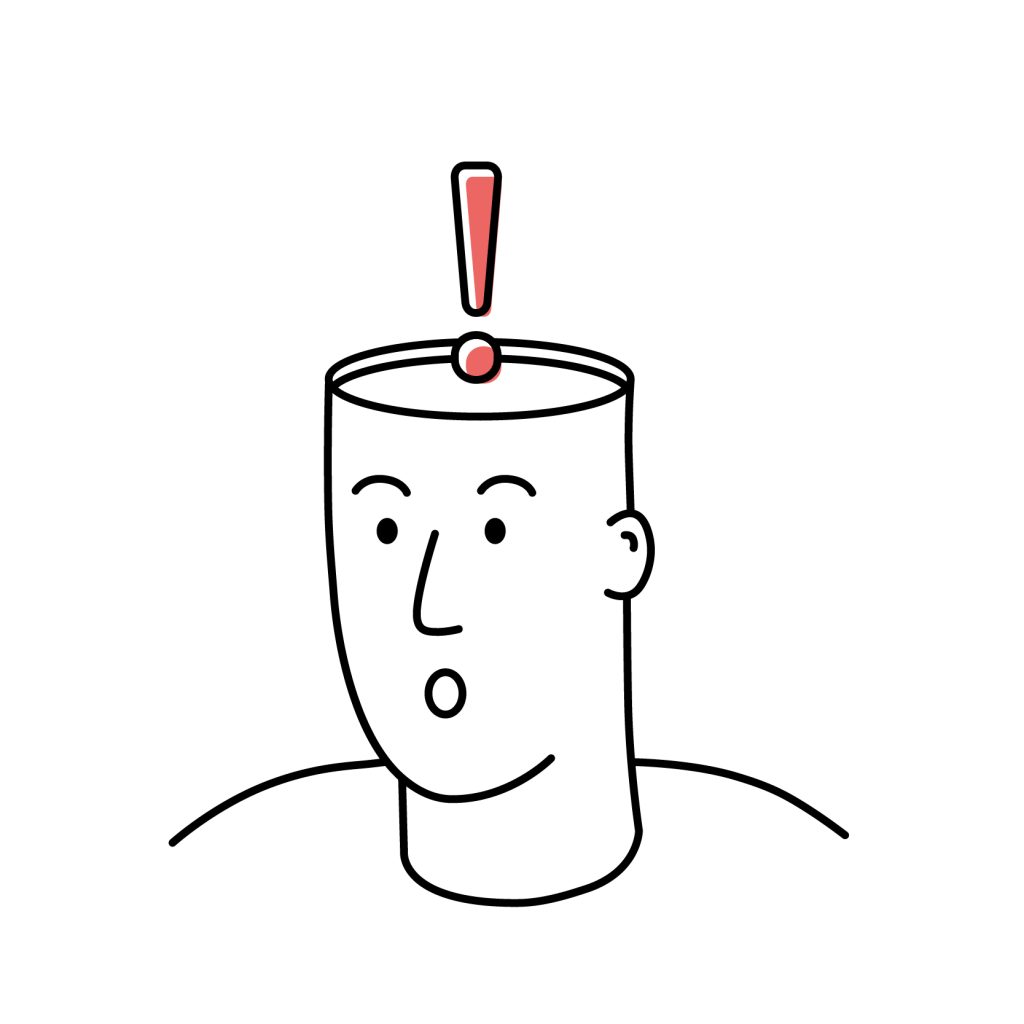
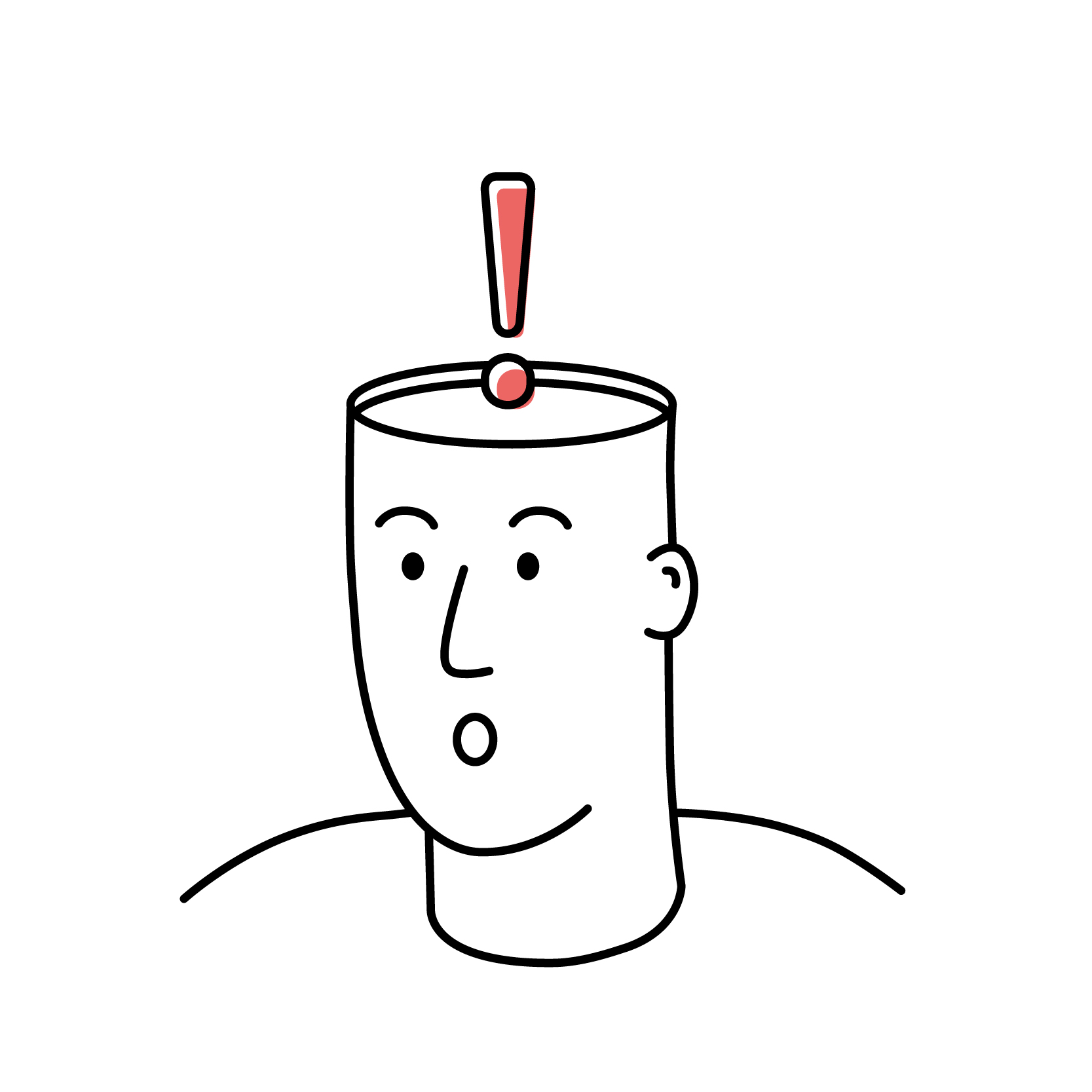 The situation: we’re in the middle of The Big Quit
The situation: we’re in the middle of The Big Quit
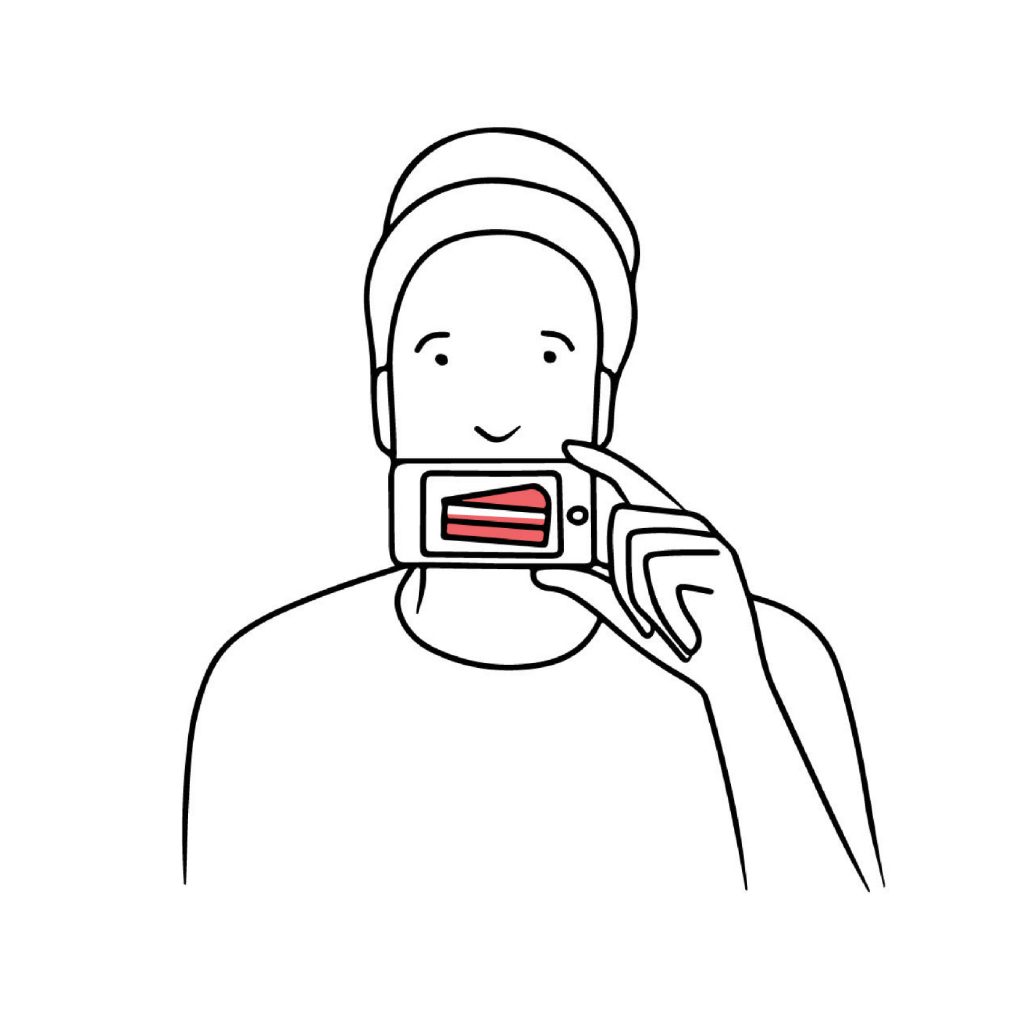
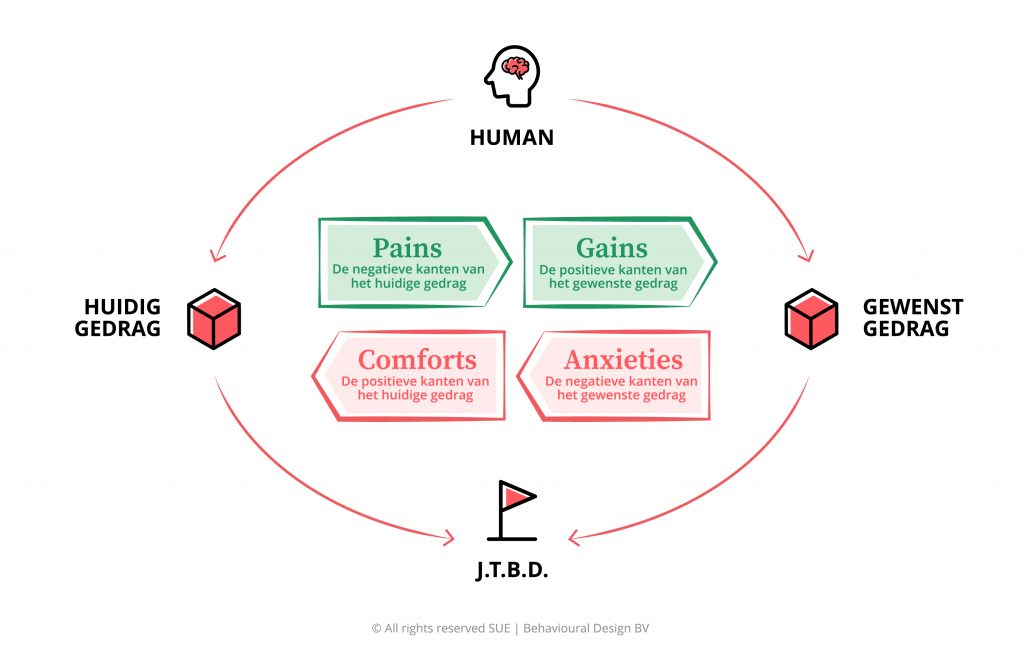
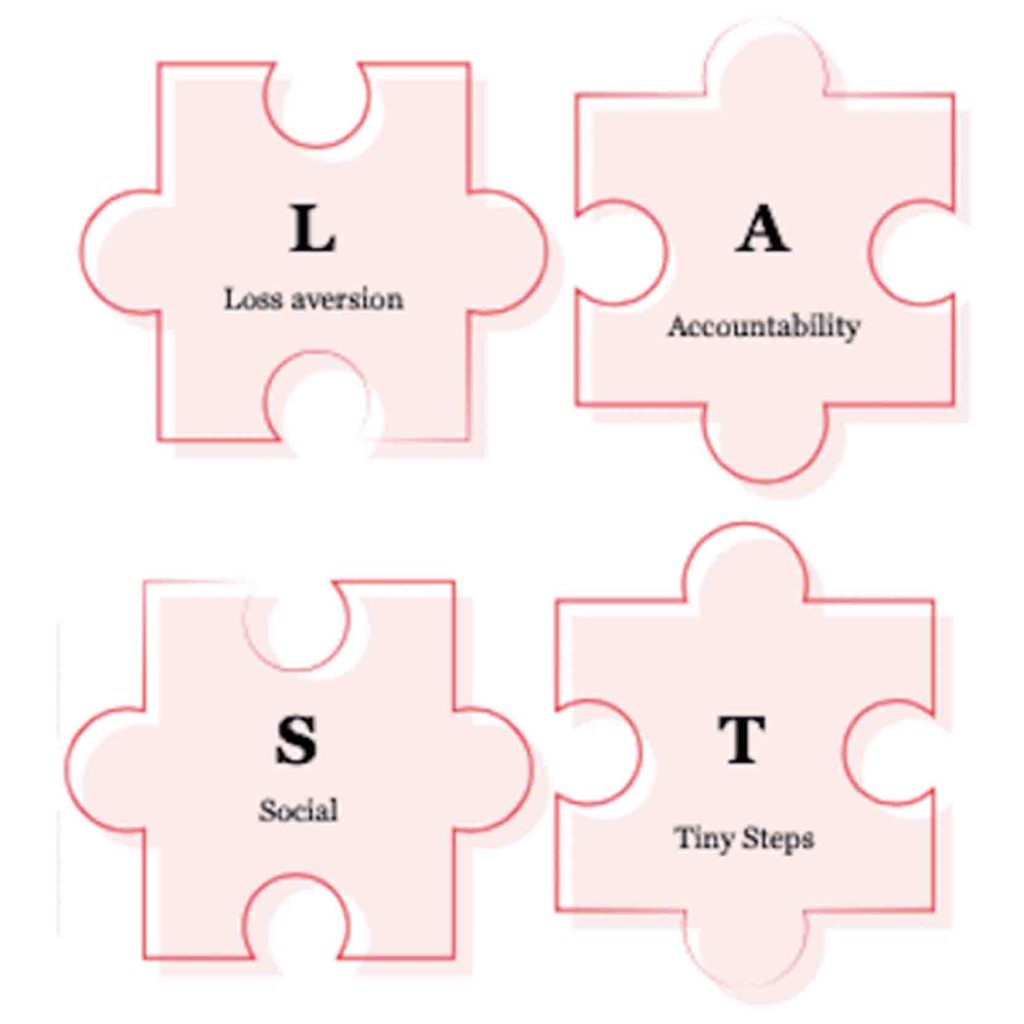


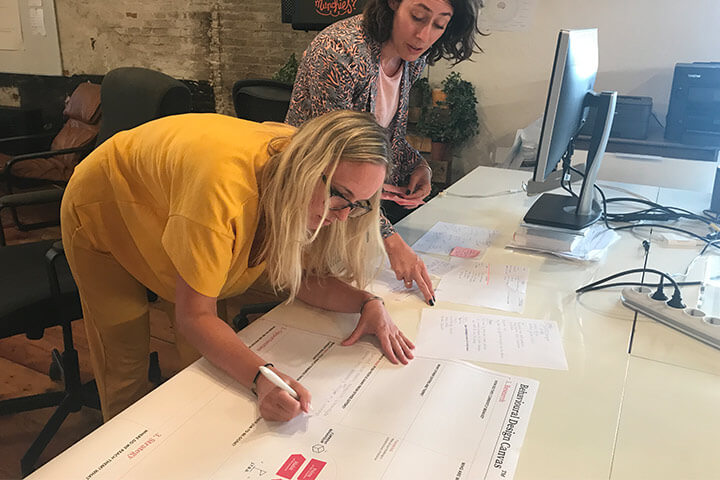

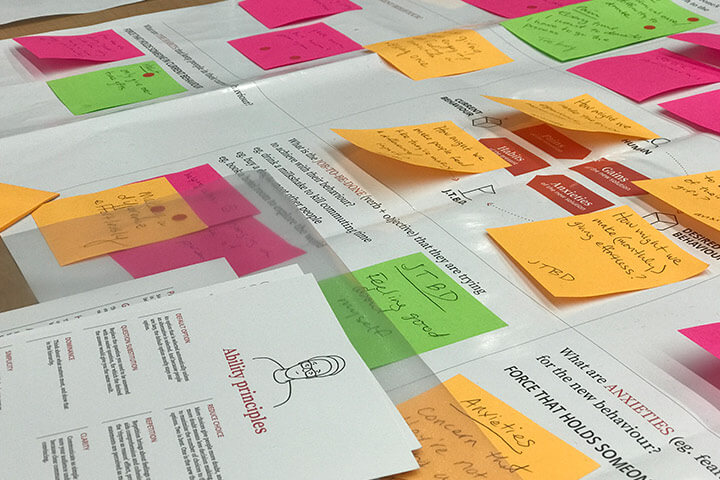
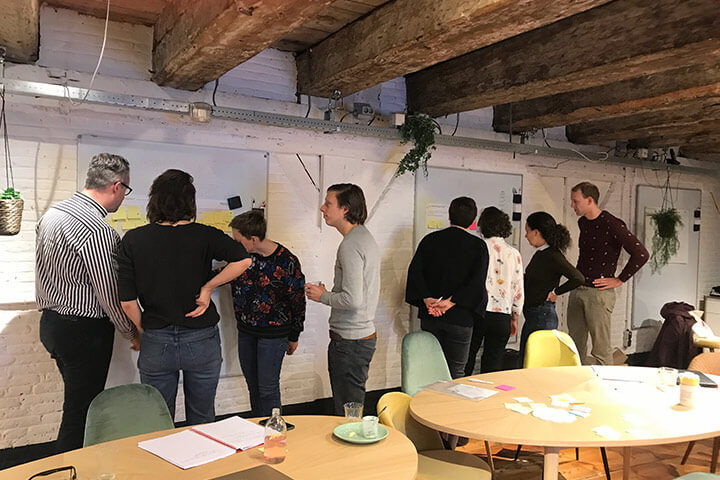
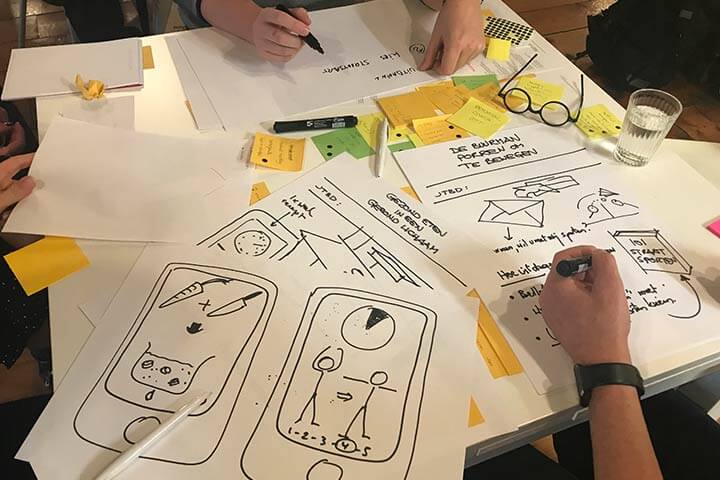



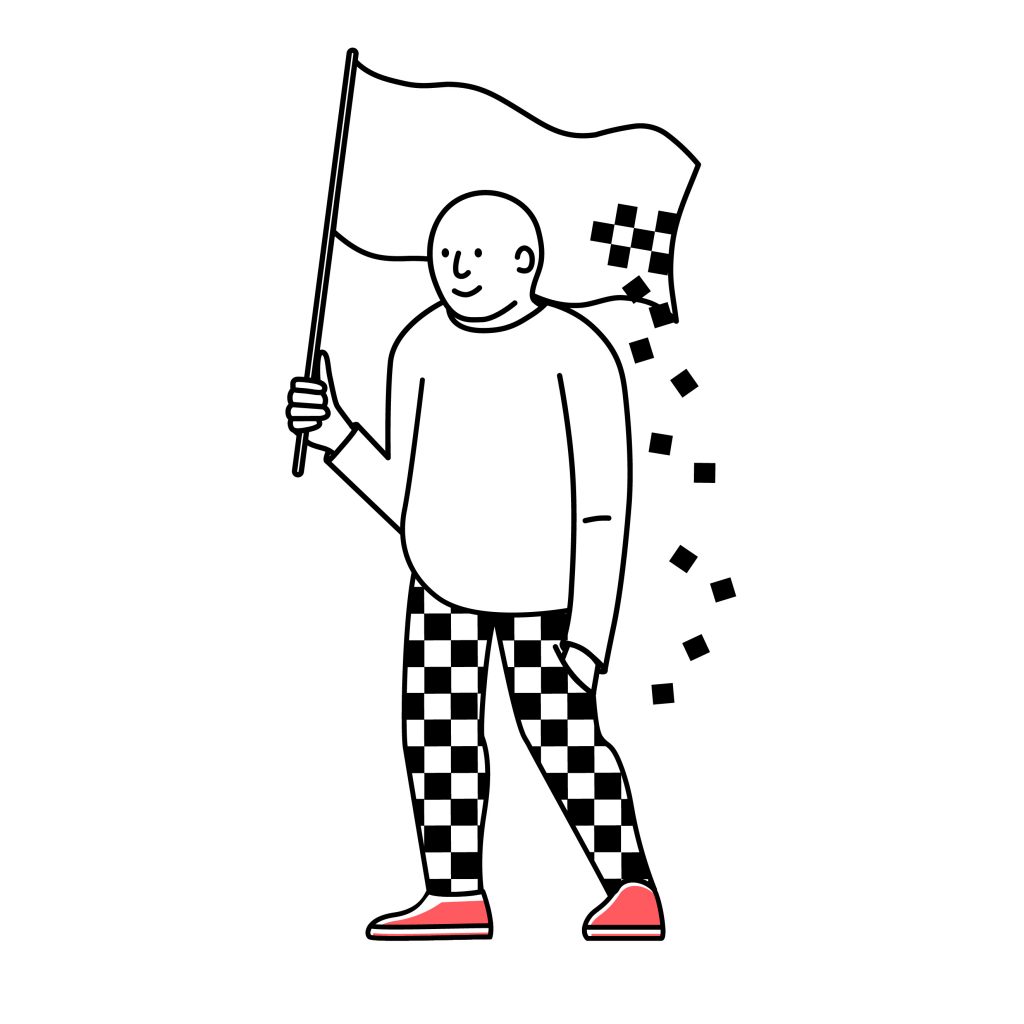
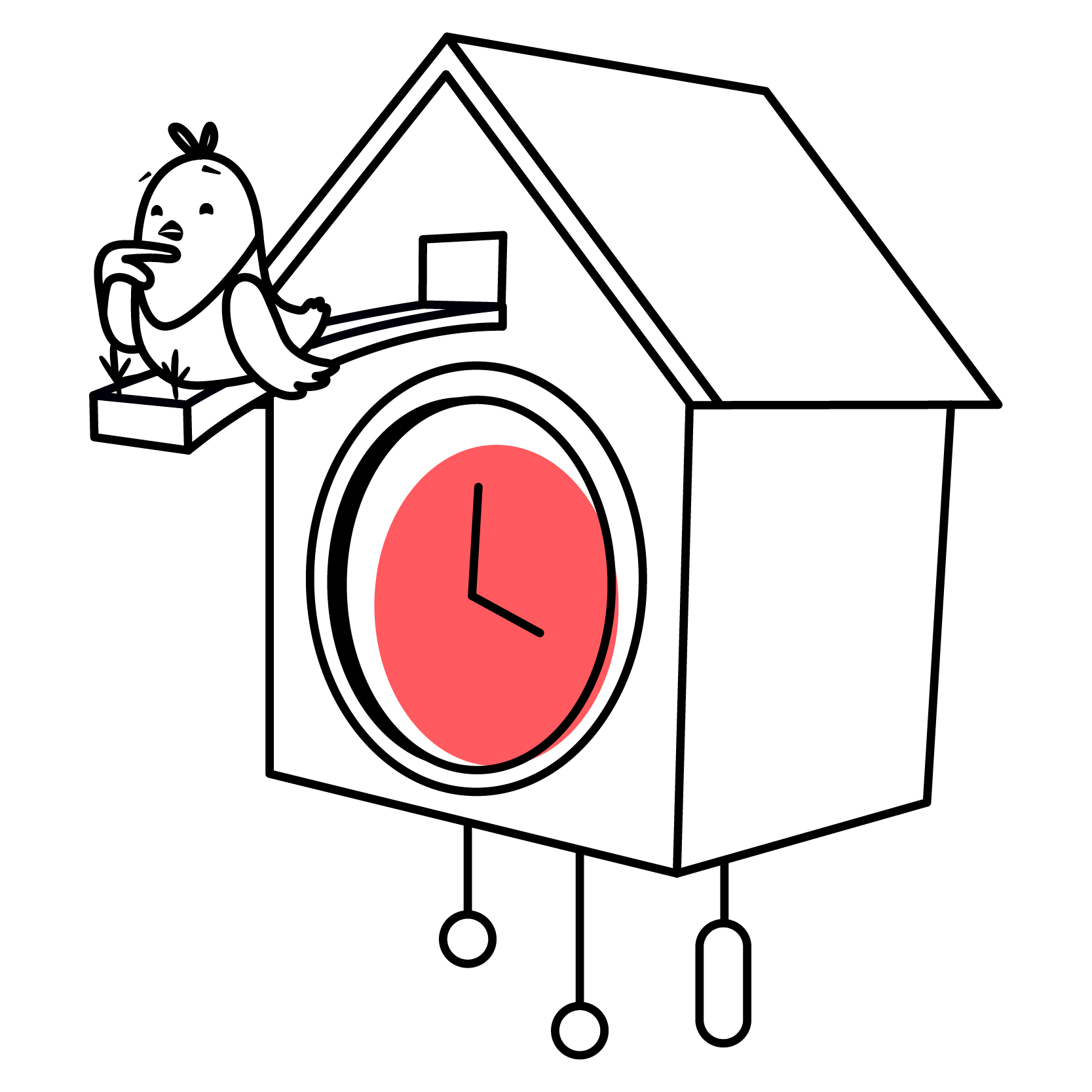
 4. Expert biases, groupthink and cherry-picking the insights that match our beliefs
4. Expert biases, groupthink and cherry-picking the insights that match our beliefs 